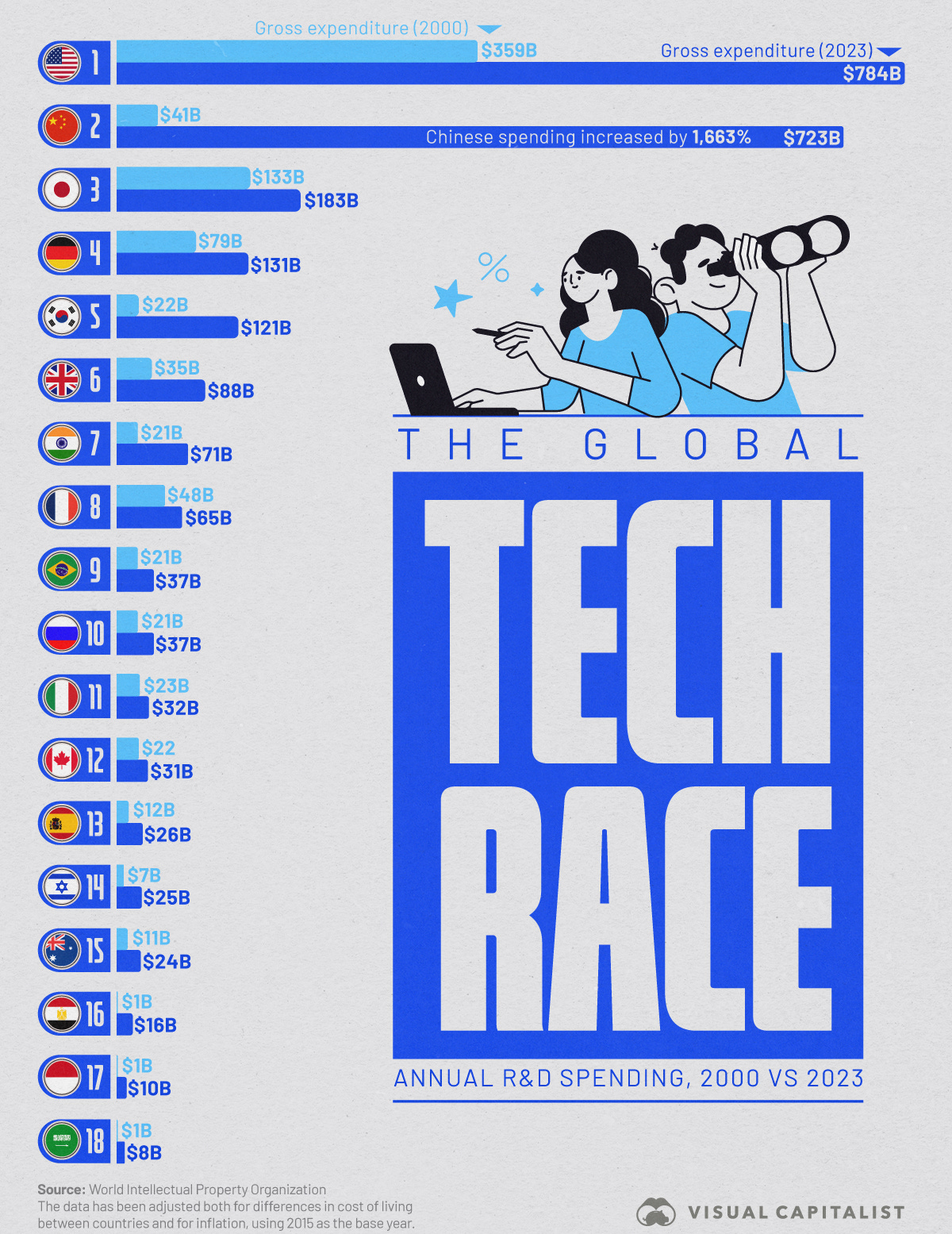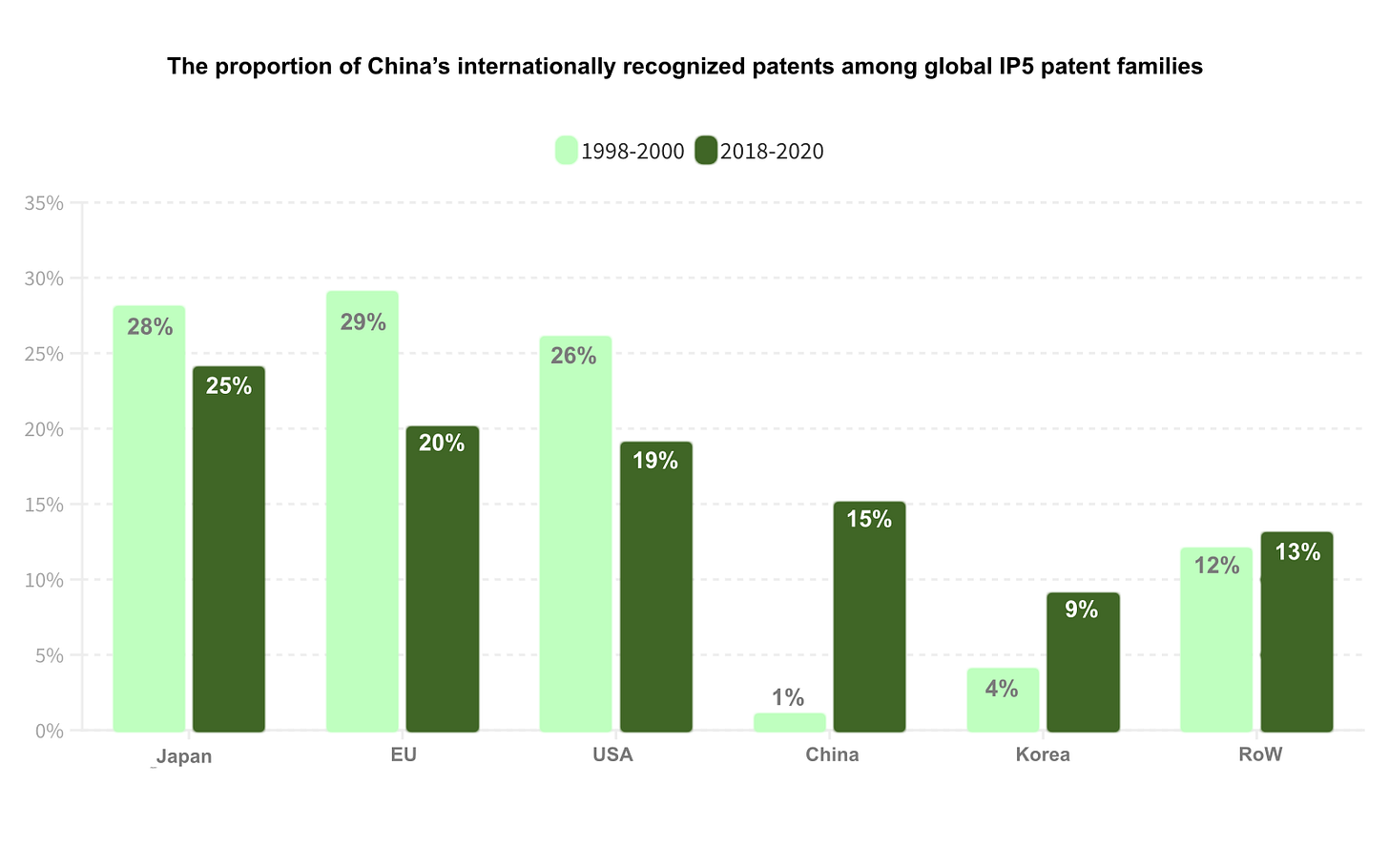China's tech revolution: from copycat to contender
Remember when "Made in China" meant cheap knockoffs? Well, those days are long gone. China has transformed itself from a manufacturing hub into a serious tech innovator that's giving Western powers a run for their money.
What I think is fascinating that China isn't just playing catch-up anymore – they are actually leading in some critical areas. Electric vehicles, batteries, AI, robotics – these aren't just industries where China participates. They are rather becoming fields where China excels.
The innovation explosion
The numbers tell a pretty impressive story. Seven (!) of the world's top ten research universities are now Chinese. By 2019, China had already surpassed the US in highly-cited scientific papers, and they're now spending almost as much on R&D as America, trailing by just $60 billion.
What about patent filings? China blew past the US in 2023 with over 70,000 applications compared to America's 60,000. And they're not just filing patents for the sake of it – they're making real advances in batteries, biotech, machine learning, and semiconductors.
In some areas like OLED displays and batteries, it seems like the US has basically given up while China keeps pushing forward. Not only are they inventing new things, but they are also masters at process innovation – making existing technologies better, faster and cheaper.
The quantum battlefield: where the future war is being fought
The tech rivalry extends beyond conventional technologies into the quantum realm, where both nations are pursuing dominance through dramatically different approaches.
The US relies on its traditional strengths – private-sector innovation, venture capital, and university research. Tech giants like Google, IBM, and Microsoft are pushing quantum computing boundaries, while startups add fresh momentum. The government mainly focuses on strategic funding and export controls rather than direct management.
China - of course - employs a state-driven model. Government entities fund most research, with state-controlled universities and labs dominating the landscape. Even major firms like Alibaba and Baidu have transferred their quantum assets to the state. This creates a tightly integrated ecosystem centered around institutions like the University of Science and Technology of China.
The results? The US leads in quantum computing hardware with companies achieving higher qubit counts and breakthrough error correction (like Google's December announcement). Meanwhile, China excels in quantum communication, having demonstrated secure, satellite-based quantum networks.
What's particularly interesting is China's push for self-sufficiency. While they have relied on Western components like specialized lasers and dilution refrigerators, several Chinese firms recently announced innovations in these areas including a record-setting refrigeration model from Zhileng Low Temperature Technology.
The secret sauce
So, what's behind China’s tech surge? Well, they have some serious advantages:
a massive logistics network that gets products where they need to go
incredible digital infrastructure (with a billion 5G subscribers!)
relatively cheap energy
an army of STEM graduates ready to innovate
These foundations make it easier for new technologies to spread throughout their economy. The result? China is now neck-and-neck with the US in many key technologies.
They're absolutely dominating in manufacturing automation with robots everywhere, though they're still playing catch-up in AI implementation (19% of Chinese companies use generative AI versus 24% in the US).
Storm clouds on the horizon
But it's not all fairy tale. China faces some pretty significant headwinds:
deflation is squeezing profits and threatening investment
government crackdowns have put a damper on private sector innovation
relations with the West are... let's just say "complicated"
US export controls, especially on semiconductors, are creating real challenges
The centralized approach has its own risks too. Reduced competition potentially stifles creativity and state-backed firms may lack incentives to innovate beyond government mandates. Resources get concentrated on a limited number of approaches deemed viable by policymakers – a strategy that could pay off big or lead to expensive dead ends.
What this means for us (investors)
The tech race is far from over. While China is good at scaling technologies efficiently ("from one to one hundred"), the US still leads breakthrough innovations ("from zero to one").
This shows up clearly in stock performance. Since 2010, the US Nasdaq has rocketed up by 1,100%, leaving Chinese tech stocks in the dust – especially since the 2021 regulatory crackdowns.
For investors, leading Chinese tech companies still offer attractive opportunities due to their cost advantages, but the geopolitical and economic challenges create more uncertainty.
My take
China's tech revolution is real and impressive, but the path forward isn't straightforward. The country needs to find a better balance between state control and market-driven innovation. If they can thread that needle, they'll be a formidable tech power for decades to come.
For now, the US retains its edge in cutting-edge areas like quantum computing hardware. But as China's domestic supply chain matures and their state-backed approach delivers results in targeted areas, American technological dominance will face its most serious challenge in generations.



